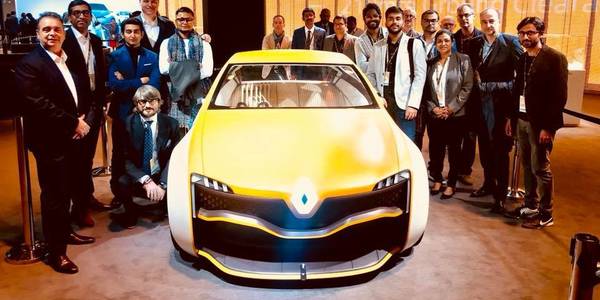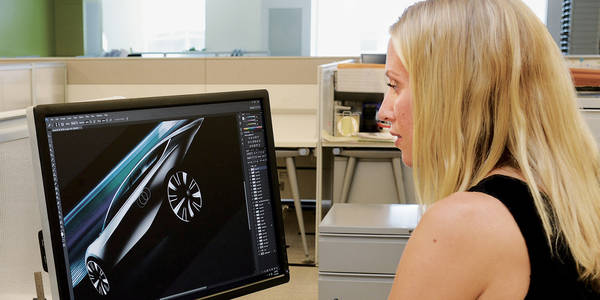feature / alumni / transportation-design
November 27, 2018
By Mike Winder
Photos by Juan Posada
Alumni Panels at Car Classic Celebrate “Iconic Design: 70 Years of ArtCenter Influence”
An event that capped a weekend-long alumni celebration that attracted 600 alumni back to ArtCenter, last month’s Car Classic—dubbed “Iconic Design: 70 Years of ArtCenter Influence”—brought together several generations of alumni to Hillside Campus to celebrate 70 years of transportation design at the College.
Three panel discussions held throughout the day featured notable alumni who spoke on the history of transportation design at the College, challenges designers face in the industry today, and projections on where the field is headed tomorrow.

Held in the morning on the main field and surrounded by the 100 vehicles on display, the first panel, “Meet the Designers I: ArtCenter Designs of Yesterday,” moderated by Matt Stone, freelance journalist and former editor at Motor Trend Classic, brought together four designers to look back on what ArtCenter meant to them personally and to discuss what gave the College its competitive edge.
The group, whom frequent Car Classic guest Jay Leno referred to as “the council of elders,” both looked back on what they gained personally from the College, and how ArtCenter maintained its competitive edge.
A few highlights:
Ron Hill (BS 1954 Transportation), former head of design at GM and former chair of Transportation Design and Industrial Design at ArtCenter, on the strength of the College:
“Things were quite a bit more remedial and low-key [at ArtCenter] in the ‘50s, but it was a really wonderful era … ArtCenter did a very good job, mainly because of the students. The students compete with one another. They learn from one another. The instructors help and guide, but [ArtCenter] has always been about the students and their facilities, their capabilities and, most of all, their creativity.”
Alum Peter Brock, designer of the Shelby Cobra Daytona Coupe and Corvette XP87 Stingray race car, fought back tears as he recounted how ArtCenter gave him a purpose:
“I came down here and walked in this place, and looked at what was on the walls and knew this was the place … I had no idea what industrial design was. I got out of high school and didn’t know what I wanted to do. I had gone to college for a while, [and] was kind of lost. I came down here [from the San Francisco Bay Area] and found a place. It was the best … Another friend of mine, Larry Shinoda (BS 54 Transportation), we were all hot rod guys, really interested in cars, and we had no idea the design business existed. So I got here … I tell you, if I hadn’t had this school…”
Chuck Pelly (BS 58 Product), former head of Designworks/USA, on learning from Ron Hill:
“They wouldn’t let me in the school because I was too young. So I found out where Ron Hill lived, up the hill, and begged [him to let me] sit in the corner and watch him draw. And he reluctantly allowed me to do that. So by the time they even allowed me to apply at ArtCenter, I had a pretty good portfolio.”
Geza Loczi (BS 65 Product), formerly Volvo’s director of design in the U.S., on learning the fundamentals:
“When I was team teaching here with David O’Connell we used to tell the students, ‘The name of the school outside is ArtCenter College of Design, not ArtCenter College of Sketch or not ArtCenter College of Rendering’ … The design is the essence of everything, but if you can’t do a good sketch or you can’t do a good rendering, you’re not going to get the attention. So you have to have the background of what ArtCenter teaches you, which is the ideation process, [and how] to delineate the forms.”
Shiro Nakamura (BS 81 Transportation), former chief creative officer at Nissan, on inspirational classmates:
“[At ArtCenter], I met great classmates, which was the biggest value for me. As Ron said, it’s [about] inspiring each other, and not only at the school. Everybody graduated [from the] school and we were influencing, inspiring each other even with the distance [between here and] the other side of the ocean. I was always thinking [about] my classmates. What were they doing? What were they thinking? … For me, it became a great benchmark.”

Moderated by Sue Calloway, editorial director at Edelman and former automotive senior editor at Time, the second panel, “Meet the Designers II: ArtCenter Designs of Today,” was held in the early afternoon on the field and focused on the current state of the industry, including major challenges transportation designers face today:
Sangyup Lee (BS 99 Transportation), vice president of Hyundai Styling Group, on the rapid pace of technology:
“We’re dealing with the biggest challenge in the history of car design. Everybody has a smartphone. Smartphones change every two years. [Right now] we’re developing cars which will come out three or four years from now. We think we’re [working] with the latest and greatest technology, but by the time the car comes out, it’s already [using] four- or five-year-old technology. And it’s going to be on the market for another five years.”
Jason Castriota (BS 00 Transportation), global brand director for BEV at Ford Motor Company, on differentiation:
“There’s a very new, real challenge to become emotive and differentiated in a space where technology is actually bringing everybody closer together. Before, you could be differentiated by an engine, a transmission, a suspension, a platform. There were all these factors that rolled into it. Now we’re in an awkward transition where we’re trying to connect cars. And we’re moving to the car actually becoming a device that just happens to be on four wheels.”
T. Jon Mayer (BS 06 Transportation), senior director of design at Volvo, on the shifting concept of the car:
“It’s a gigantic shift. Probably the biggest ever in the concept of a car. Maybe mobility is the better term because it moves us out of the realm of ownership. It becomes a lot of stuff when you talk about sharing. It’s an object you touch, sit in, and breathe in with another individual. The one thing that doesn’t change is that we’re all humans. It needs to be designed around that from the get-go. As far as what that experience is like, nobody has cracked that code yet.”
Dave Marek (BS 87 Transportation), executive creative director for Acura at Honda R&D, on why technology won’t destroy the luxury market:
“Of course there will be new business, car sharing, mobility. [Even if we’re] going to have total autonomy, we are still going to want to buy clothes that look cooler than the next guy. We’re still going to want to valet park. Here’s where you can win with your brand. Why are people buying a $1,000 iPhone? Because it’s cool, or it looks better, or it’s, ‘Hey, look what I got.’ ‘Keeping up with the Joneses’ is not going away. It’s just not.”

The last panel of the day, “Meet the Designers III: ArtCenter Designs of Tomorrow,” took place later in the afternoon inside the College’s Hyundai and Kia Innovation Center. Moderated by Geoff Wardle, executive director of the College’s Transportation Systems and Design MFA program, the panel further examined challenges in the industry while also looking forward to where the field may head in the next 20 years.
Page Beerman (BS 86 Transportation), design director at Faraday Future, on vehicles versus smartphones:
“[Smartphones] are all essentially the same form factor. What differentiates them from their competitors is the experience you have once you’re on the screen. If you apply that thinking to [the automotive industry], you’re going to end up with vehicles that look very much the same on the inside and the outside and what they display on their surfaces is different. The operating system, and the functions and features that you can access through this screen is what’s going to differentiate the brands. But the car is such a unique object in our society. It evokes freedom. It evokes so much emotion that I don’t think you can really pursue that scenario. I think the way the vehicles will have to differentiate themselves is still having people fall in love with them.”
Derek Jenkins (BS 93 Transportation), vice president of design for Lucid Motors and former director of design for Mazda North America Operations, on the evolving role of designers:
“That future is out there. Sometimes that’s hard to accept. But I think design is going to play a huge role in that [future]. It’s going to be less about [creating] an emotional style and more [about] designing an end-to-end experience. If I’m signing up for XYZ mobility services, what am I signing up for? What am I getting? Is it the Starbucks of mobility? The Virgin level? The Four Seasons service? … More and more people will be thinking about that and less about how fast [a vehicle] goes from 0-60 MPH … It frightens me, but that [shift] is solving serious problems and is necessary going forward. Within that context, I could see a scenario where I’m signing up for an enthusiast service to utilize a palette of vehicles.”
Sasha Selipanov (BS 05 Transportation), chief designer, global advanced design at Genesis, speculated on what the smartphone model could mean for automotive design:
“This reminds me of a meteor crashing to earth ... an extinction-level event. [It’s] what we in the automotive industry are going to go through in the next few years. It’s a little bit like what happened in the phone industry … There’s really only two [choices]: iOS and Android. And Android makers have effectively lost any sort of brand identity because they’ve completely gone anonymous … The mainstream car industry sooner or later will realize that it doesn’t make sense to invest the same amount of money to come up with the same solutions to the same questions. Everybody will start to buy these solutions off the shelf.”
Please visit artcenter.edu/carclassic for more information on this year’s Car Classic, as well as an archive of Car Classics dating back to 2012. For a list of 2018 Car Classic Judges Choices, please see the press release on the College’s Press Room.






